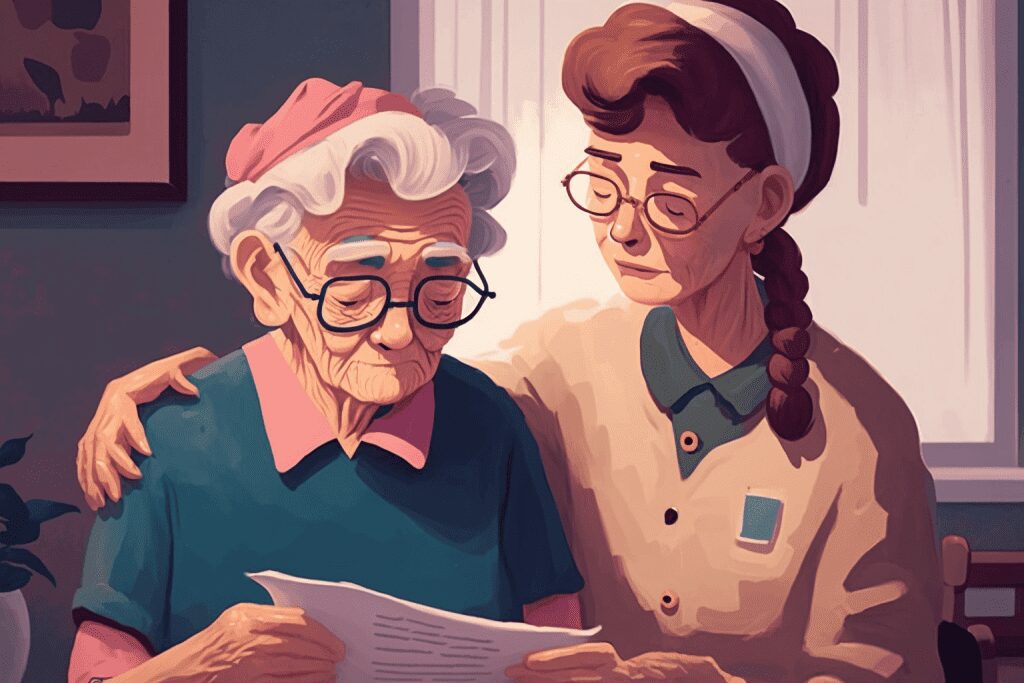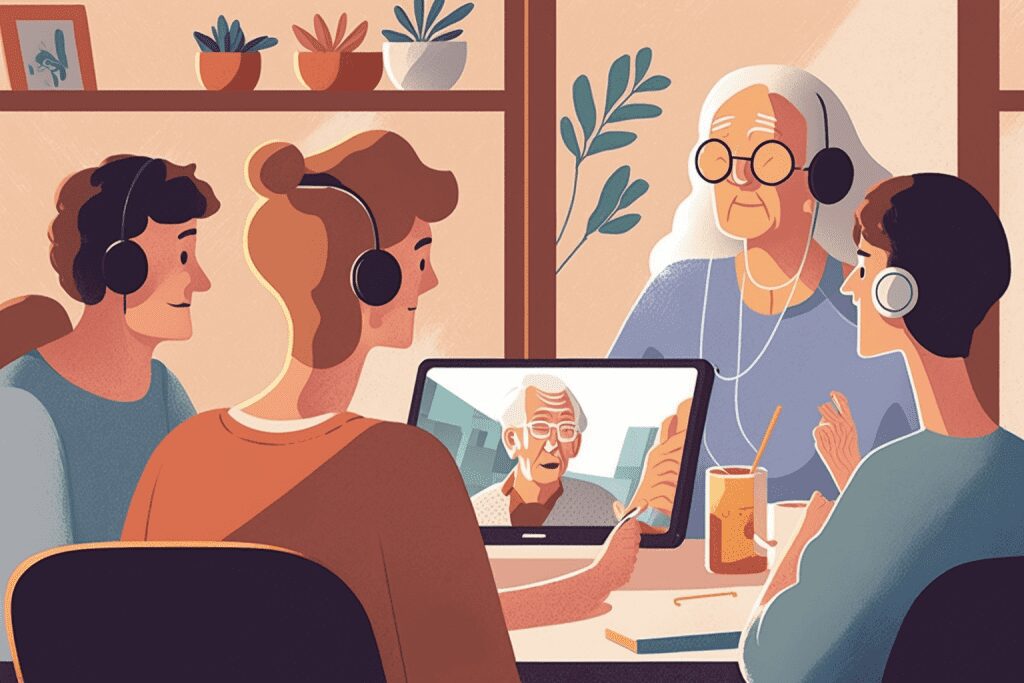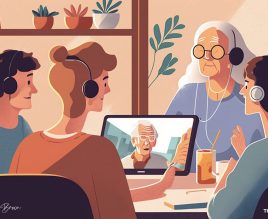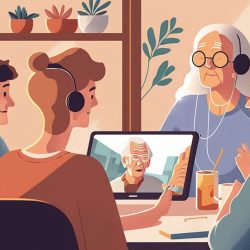Table of Contents
ToggleDiscover the future of healthcare with digital health solutions and effective chronic care management in our today’s article.
Digital health, in particular, has significantly enhanced health monitoring for seniors. Gone are the days of infrequent doctor visits and incomplete health records. Today, older adults can keep track of their health parameters regularly using smart devices and mobile applications. Such comprehensive and continuous health monitoring contributes significantly to improved health outcomes and early disease detection.
But this digital revolution isn’t just about health monitoring. Remote patient monitoring and chronic disease management have brought in a new era of proactive healthcare. These technological solutions empower older adults, enabling them to manage their health more effectively and actively participate in their healthcare journey.
In this article, we explore the world of digital health, focusing on health monitoring, remote patient monitoring, and chronic disease management. We aim to shed light on how these digital health solutions are transforming healthcare for older adults and potentially improving their quality of life.
Health Monitoring for Seniors
Health monitoring for seniors is a crucial component of modern healthcare. It involves the systematic tracking of health indicators, including vital signs, physical activity, and cognitive health, using digital health technologies. As the aging population increases, the demand for innovative health monitoring solutions is more apparent than ever.

The Importance of Health Monitoring for Older Adults
As seniors age, they often experience a myriad of health issues. Regular health monitoring becomes increasingly vital to detect problems early, manage existing conditions, and ultimately improve the quality of life. With the advent of digital health technology, health monitoring has become more accessible, efficient, and reliable.
1. Aging Population and Healthcare Challenges
The world’s aging population is growing at an unprecedented rate. By 2050, the number of individuals aged 65 and over is expected to nearly double from 2018 levels. This demographic shift presents healthcare systems with numerous challenges. The increased demand for care, coupled with the chronic nature of many age-related diseases, strains the existing healthcare infrastructure.
Besides, accessibility to regular health checkups remains a significant concern, especially in remote areas. The need for advanced health monitoring for seniors is apparent in this context. By leveraging digital health technology, we can address these issues head-on, delivering personalized and timely care to older adults irrespective of their location.
2. Improving Health Outcomes and Quality of Life
Health monitoring plays a pivotal role in improving health outcomes for older adults. Regular monitoring can aid in early detection of diseases, allowing for timely intervention and better management of health conditions. In addition, it gives older adults a sense of control over their health, encouraging adherence to treatment plans.
Furthermore, health monitoring contributes to improved quality of life. It reduces the need for frequent hospital visits and allows seniors to age in place, promoting their autonomy and well-being. With the help of digital health tools, older adults can now take an active role in managing their health, leading to better outcomes and improved quality of life.
Innovative Health Monitoring Technologies for Seniors
The realm of digital health has seen a surge of innovative technologies designed to augment health monitoring for seniors. From wearable devices to mobile health apps, these technologies provide accurate, real-time data on various health parameters, ensuring early detection and management of potential health issues.
1. Wearable Devices and Sensors
Wearable technology provides a continuous stream of real-time data, allowing for early detection of abnormal patterns or health deterioration. This capacity for early detection can be lifesaving in cases of cardiac events or falls. Furthermore, wearables offer an element of convenience; they’re often easy to use, non-invasive, and can seamlessly integrate into the daily routines of seniors.
The real potential of wearable technology lies in its ability to empower older adults to be proactive about their health. It provides them with insights into their health status and encourages them to maintain a healthy lifestyle. In a sense, wearables are turning the traditional healthcare model on its head, shifting the focus from reactive care to proactive, preventative care.
2. Mobile Health Apps
Mobile health apps are another digital health innovation contributing to better health monitoring for seniors. These apps can track nutrition, physical activity, medication intake, and even mental health, serving as comprehensive digital health journals. They can also provide personalized health advice, reminding users to take their medication, hydrate, or exercise regularly.
Some apps go a step further by integrating data from wearable devices, creating an all-encompassing health dashboard. These apps can alert users and healthcare providers about potential health concerns, facilitating prompt intervention.
Moreover, mobile health apps often incorporate features such as teleconsultations and digital prescriptions, making healthcare even more accessible to seniors. They essentially bring healthcare to the palms of older adults, promoting proactive self-care and better health outcomes.
Overcoming Barriers to Health Monitoring Adoption
While digital health technologies hold tremendous potential, their adoption isn’t without challenges. Concerns about privacy and security, along with ensuring ease of use and accessibility for older adults, are key hurdles that need to be overcome to facilitate widespread adoption of health monitoring solutions.

3. Addressing Concerns About Privacy and Security
The use of digital health technologies raises valid concerns about the privacy and security of sensitive health data. Breaches can lead to exposure of personal information, potentially resulting in misuse. It’s imperative for healthcare providers and technology developers to prioritize data security.
This involves employing robust encryption methods to protect data during transmission and storage. Regular security audits and updates are also essential to identify and fix vulnerabilities promptly. Regulatory compliance with standards like HIPAA in the U.S. or GDPR in Europe is a crucial step towards ensuring data privacy.
In addition, educating older adults about data privacy, their rights, and how their data is used and protected can foster trust in these technologies. By addressing privacy and security concerns proactively, we can pave the way for wider acceptance of health monitoring solutions.
4. Ensuring Ease of Use and Accessibility
A significant barrier to the adoption of health monitoring technologies among older adults is their perceived complexity. To address this, developers must prioritize user-friendly design and simple interfaces that are easy for seniors to navigate. Tutorials, guides, and customer support can further assist in making technology more approachable for older users.
Accessibility is another concern. Not all seniors may have access to smartphones or internet connectivity required for these technologies. To overcome this, health monitoring solutions need to be made affordable and compatible with a variety of devices. Offering offline functionality or ensuring services are accessible even with low-speed internet can make a difference.
Lastly, creating digital health technologies that are senior-friendly doesn’t just involve overcoming technical hurdles. It’s about understanding their unique needs and challenges and designing solutions that address these effectively. By doing so, we can ensure that the benefits of health monitoring are accessible to all older adults.
Remote Patient Monitoring: Benefits and Applications
Remote Patient Monitoring (RPM) is a game-changer in healthcare, especially for older adults. It allows healthcare providers to monitor patients’ health data in real-time, providing timely care and improving patient outcomes. This section delves into the advantages of RPM and its applications in senior care.

The Advantages of Remote Patient Monitoring for Older Adults
Remote patient monitoring offers numerous benefits for older adults, notably reducing the need for hospital visits, enhancing patient-provider communication, and facilitating personalized care. By leveraging RPM, seniors can maintain their independence while receiving the healthcare attention they require.
1. Reducing Hospital Visits and Readmissions
One of the most significant benefits of RPM for older adults is the potential to reduce the frequency of hospital visits and readmissions. Traditional healthcare often involves frequent trips to the doctor for routine check-ups or monitoring of chronic conditions. These visits can be taxing, both physically and financially.
With RPM, seniors can have their health parameters monitored remotely, without leaving the comfort of their homes. These data can alert healthcare providers about any potential health risks, facilitating early intervention and potentially preventing hospitalization. Moreover, in the event of a hospital stay, RPM can aid in post-discharge monitoring, reducing the risk of readmission.
The result is fewer trips to the hospital, less stress, and potentially lower healthcare costs, making it a win-win situation for older adults.
2. Enhancing Patient-Provider Communication
Another advantage of RPM is its capacity to enhance patient-provider communication. Traditionally, communication with healthcare providers is limited to infrequent, often rushed, office visits. But RPM fosters a continuous dialogue.
RPM systems can relay health data from the patient to the provider in real-time, providing a comprehensive and timely picture of the patient’s health. This transparency allows providers to respond promptly to any changes in the patient’s condition and provides opportunities for real-time feedback and education.
Furthermore, this continuous communication can help build stronger relationships between patients and providers. It fosters a sense of trust and collaboration, which can significantly enhance patient satisfaction and engagement in their own care.
Telehealth Services and Remote Patient Monitoring Systems
The advent of telehealth services has significantly bolstered the capabilities of remote patient monitoring systems. By integrating telemedicine consultations and real-time data tracking, these systems are transforming the delivery of healthcare to older adults, making it more convenient, effective, and personalized.
1. Telemedicine Consultations
Telemedicine consultations are a key feature of modern remote patient monitoring systems. These virtual appointments allow older adults to connect with their healthcare providers from the comfort of their own homes. This is particularly beneficial for those with mobility issues or those living in remote areas.
Telemedicine consultations can encompass various forms of healthcare, including primary care, specialty care, mental health services, and even health and wellness advice. They can be used for routine check-ups, follow-ups, medication management, and immediate care for non-emergency health issues.
In addition to convenience, telemedicine consultations can also improve the quality of care. They allow for more frequent contact with healthcare providers, which can lead to better management of chronic conditions, quicker adjustments to treatment plans, and ultimately, better health outcomes. Furthermore, these virtual consultations can provide a sense of comfort and security for older adults, knowing that professional medical help is just a video call away.
2. Real-time Data Tracking and Alerts
Wearable sensors and smart devices can continuously monitor vital signs such as heart rate, blood pressure, glucose levels, and more. This data is automatically uploaded to a secure platform accessible by healthcare providers, providing them with real-time insight into the patient’s health status.
Automated alerts can be set up based on certain criteria. For instance, if a patient’s blood pressure rises above a safe level, the system can immediately alert both the patient and their healthcare provider. This rapid response mechanism can allow for immediate intervention, preventing minor issues from escalating into serious health crises.
Real-time data tracking and alerts not only lead to proactive care but also empower older adults to be active participants in their own healthcare. They foster a sense of control and reassurance, knowing that their health is being closely monitored and that help is available when needed.
Real-Life Examples of Remote Patient Monitoring Success Stories
Remote patient monitoring has already made a significant impact on the lives of many older adults, particularly those living with chronic conditions. These success stories, both individual and at a larger scale, illustrate the transformative potential of RPM in enhancing patient outcomes and empowering seniors to take control of their health.
1. Improving Outcomes for Patients with Chronic Conditions
RPM has been a game-changer for managing chronic conditions. Consider the story of Mrs. Smith, a 75-year-old patient with congestive heart failure. Before RPM, Mrs. Smith was frequently hospitalized due to complications from her condition, which led to substantial emotional and financial stress.
With the introduction of an RPM system, Mrs. Smith’s healthcare team could monitor her vitals continuously. Real-time data allowed for early detection of signs of fluid buildup – a common problem in heart failure. By adjusting her treatment promptly, they were able to prevent severe episodes and subsequent hospitalizations.
This individual story mirrors larger studies on RPM effectiveness. A study by the Veterans Health Administration in the US showed a 25% reduction in bed days of care and a 19% reduction in hospital admissions among chronic disease patients using RPM. These cases underline the tangible benefits of RPM in improving health outcomes for patients with chronic conditions.
2. Empowering Seniors to Take Control of Their Health
John, an 80-year-old with diabetes, struggled with maintaining his blood sugar levels, leading to frequent health scares. Introducing RPM into John’s care regime turned his situation around. A wearable device monitored his blood glucose levels in real-time, alerting him when his sugar levels were too high or too low.
With this information, John could adjust his insulin dosage and diet as needed. The constant feedback helped him understand the relationship between his lifestyle choices and his blood sugar levels. Over time, he took more control over managing his condition, which resulted in more stable blood glucose levels and fewer health emergencies.
Stories like John’s are becoming more common. With RPM, seniors gain a better understanding of their health and feel more empowered to take actions that improve their health and well-being. The combination of knowledge, control, and timely intervention afforded by RPM is truly empowering older adults to take charge of their health.
Chronic Disease Management in Older Adults
Chronic disease management is a critical issue in elder care. With older adults disproportionately affected by chronic conditions, managing these diseases effectively is key to enhancing their quality of life and reducing healthcare costs. This section explores the burden of chronic diseases on seniors and healthcare systems.

The Burden of Chronic Diseases on Seniors and Healthcare Systems
Chronic diseases pose a significant burden on older adults, impacting their daily lives, independence, and overall health. Moreover, they strain healthcare systems, increasing healthcare costs, and consuming resources. Understanding the prevalence of these conditions among seniors and their impact on healthcare resources is vital for devising effective strategies for chronic disease management.
1. Prevalence of Chronic Conditions Among Older Adults
Chronic conditions are prevalent among older adults. According to the U.S. Centers for Disease Control and Prevention, 85% of older adults in the United States have at least one chronic condition, and 60% have two or more. The most common include heart disease, cancer, chronic lower respiratory diseases, stroke, Alzheimer’s disease, diabetes, and arthritis.
These conditions often lead to decreased mobility, diminished quality of life, and increased mortality. Moreover, having multiple chronic conditions, or multimorbidity, is common in older adults and poses an even greater challenge. It complicates disease management, increases the risk of adverse drug events due to polypharmacy, and often leads to poorer health outcomes. Thus, chronic disease management is a critical aspect of healthcare for older adults, requiring effective strategies for prevention, treatment, and control of these conditions.
2. The Impact on Healthcare Costs and Resources
The high prevalence of chronic diseases among older adults places a considerable strain on healthcare systems. Chronic diseases are leading drivers of healthcare costs. In the U.S., 90% of the nation’s $3.8 trillion in annual healthcare expenses are for people with chronic and mental health conditions.
Treating and managing chronic diseases require substantial healthcare resources, from hospital beds to healthcare professionals’ time. They account for a significant portion of hospital admissions and doctor visits and are a leading cause of disability, often requiring long-term care or rehabilitation.
Additionally, chronic diseases can lead to complications that require further treatment, contributing to higher healthcare costs. For instance, diabetes can lead to a range of complications, from heart disease and stroke to kidney failure and lower-limb amputations, all of which require additional care. Clearly, effective chronic disease management is not just vital for improving the health and well-being of older adults, but it’s also crucial for the sustainability of healthcare systems.
Digital Health Solutions for Chronic Disease Management
Digital health solutions offer promising strategies for managing chronic diseases among older adults. With their ability to provide personalized care plans, aid in medication management, deliver digital therapeutics, and facilitate behavior change interventions, they are poised to revolutionize chronic disease management.
1. Personalized Care Plans and Medication Management
Digital health solutions can aid in developing personalized care plans, a cornerstone of effective chronic disease management. Personalized care plans take into account the unique needs, preferences, and circumstances of each patient, which can lead to better engagement and improved health outcomes.
For example, an RPM system can collect a wealth of data about an individual’s health status, lifestyle, and response to treatment. This data can be used to tailor care plans to the individual, adjusting for factors like physical ability, comorbidities, and personal goals.
In addition, digital health solutions can assist with medication management, a crucial aspect of chronic disease management. For instance, mobile health apps can provide reminders for medication intake, track medication use, and alert healthcare providers if a dose is missed. This can help ensure adherence to medication regimens, reducing the risk of complications and improving disease control.
2. Digital Therapeutics and Behavior Change Interventions
Another promising application of digital health in chronic disease management is in the field of digital therapeutics. Digital therapeutics are software programs that can provide medical interventions directly to patients. For instance, a digital therapeutic might offer cognitive behavioral therapy for managing chronic pain or provide coaching for self-management of diabetes.
Digital health solutions can also support behavior change interventions. These are strategies designed to help individuals adopt healthy behaviors, like regular physical activity, healthy eating, stress management, and smoking cessation. Mobile health apps, for example, can provide education, motivation, and real-time feedback, helping individuals make and sustain lifestyle changes.
Through these interventions, digital health can empower older adults to take an active role in managing their chronic conditions, potentially leading to better health outcomes and improved quality of life.
Empowering Seniors to Self-Manage Chronic Conditions
Empowering older adults to self-manage their chronic conditions is a vital aspect of chronic disease management. This involves supporting them in adhering to treatment plans and fostering their engagement and self-efficacy. Digital health solutions can play a pivotal role in this empowerment process, enhancing the patient’s role in managing their own health.
1. Encouraging Adherence to Treatment Plans
One of the challenges in chronic disease management is ensuring adherence to treatment plans. This involves not only taking medications as prescribed but also following dietary recommendations, exercising regularly, and attending follow-up appointments.
Digital health solutions can support adherence in multiple ways. For instance, mobile apps can provide reminders to take medications, attend appointments, or perform exercises. Wearable devices can monitor physical activity levels and provide feedback, encouraging regular exercise.
Additionally, RPM systems can provide real-time feedback to both patients and healthcare providers. If a patient’s vitals suggest non-adherence (for instance, rising blood glucose levels in a patient with diabetes), healthcare providers can intervene promptly. This real-time feedback can motivate patients to adhere to their treatment plans, knowing that their actions directly impact their health metrics.
2. Fostering Patient Engagement and Self-Efficacy
Engaging patients in their care and fostering their belief in their ability to manage their conditions – their self-efficacy – are key elements of self-management. When patients are engaged, they are more likely to adhere to treatment plans and make lifestyle changes that promote their health.
Digital health solutions can support patient engagement and self-efficacy in various ways. Providing accessible information about their condition and treatment can empower patients, helping them make informed decisions about their care. Gamification features can motivate patients to achieve health goals, while social features can create a sense of community, providing peer support.
Moreover, seeing the impact of their actions on their health data can strengthen patients’ self-efficacy. For example, a patient who sees their blood pressure improve as they regularly take their medication and exercise can gain confidence in their ability to manage their condition.
By encouraging adherence and fostering engagement and self-efficacy, digital health solutions can empower seniors to take charge of their chronic conditions, leading to better health outcomes.
Implications and Future Developments
As we delve deeper into the era of digital health, it’s crucial to consider the implications of this revolution in healthcare and the exciting future developments it heralds. This section will focus on the expanding role of digital health in senior care, examining how it’s being integrated into care models and exploring emerging innovations in health technology for older adults.
The Expanding Role of Digital Health in Senior Care
Digital health is poised to play an ever-growing role in senior care. With its potential to personalize care, improve health outcomes, and empower patients, it’s becoming a central component of care models for older adults. This section will explore how digital health solutions are being integrated into these models and the innovative developments on the horizon.
1. Integration of Digital Health Solutions into Care Models
The integration of digital health solutions into care models for older adults is transforming the way care is delivered. RPM systems, telehealth services, mobile health apps, and digital therapeutics are being incorporated into care plans, often working in tandem to provide comprehensive care.
For instance, an RPM system can collect a wealth of patient data, which can then inform telehealth consultations, personalized care plans, and digital therapeutic interventions. These technologies can work together to provide continuous, patient-centered care.
Furthermore, digital health solutions are facilitating a shift toward preventative care. With their ability to provide real-time data and detect early signs of health problems, they can help prevent acute episodes and disease progression, leading to better health outcomes and reduced healthcare costs.
2. Innovations in Health Technology for Older Adults
As technology advances, we can expect to see exciting new innovations in health technology for older adults. Artificial intelligence (AI) and machine learning algorithms are being developed to analyze patient data more accurately, predict health outcomes, and personalize care.
Innovations are also happening in the realm of wearable technology. For instance, there are developments towards smart clothes and smart homes. Smart clothes can monitor health metrics without the need for a separate device, while smart homes can detect changes in daily activities, like sleeping patterns or mobility, which could indicate health problems.
Virtual and augmented reality technologies are also being explored for their potential in physical therapy, cognitive training, and social connection. These future developments have the potential to further revolutionize senior care, making healthcare more proactive, personalized, and patient-centered.
Challenges and Opportunities in Digital Health Adoption
While digital health holds great promise for enhancing senior care, its adoption also comes with certain challenges. These include ensuring equitable access to digital health solutions and addressing concerns about data privacy and security. However, these challenges also present opportunities to refine digital health technologies and make them even more impactful.
1. Ensuring Equitable Access to Digital Health Solutions
One of the primary challenges in digital health is ensuring that all older adults have equitable access to these solutions. This involves overcoming the digital divide – disparities in internet access and digital literacy. Older adults in rural areas, low-income individuals, and those with limited education or language proficiency are often at a disadvantage when it comes to using digital health solutions.
However, this challenge presents opportunities for innovation. For example, designing intuitive, easy-to-use interfaces can help older adults with limited digital skills navigate health technologies. Offering training and support can also improve digital literacy and confidence. In addition, efforts to expand broadband access in underserved areas can help ensure that more older adults can benefit from digital health.
2. Addressing Concerns about Data Privacy and Security
As digital health solutions collect sensitive health data, concerns about data privacy and security are paramount. Patients need to trust that their data is protected and used appropriately.
Healthcare providers and technology developers have a responsibility to ensure robust data protection measures are in place. This includes encrypting data, ensuring secure data transmission, and being transparent about how data is used.
In addition, regulations like the Health Insurance Portability and Accountability Act (HIPAA) in the U.S. provide guidelines for protecting patient privacy. Compliance with such regulations is crucial. Despite these challenges, addressing privacy and security concerns can also enhance patient trust and engagement, driving wider adoption of digital health solutions.
Conclusion
The digital health revolution is transforming the landscape of senior care. Through health monitoring, remote patient monitoring, and chronic disease management technologies, we are witnessing the birth of more personalized, patient-centered, and proactive healthcare for older adults.
Despite challenges in areas like equitable access and data privacy, these hurdles also open up opportunities for growth and innovation. As we address these issues, the potential of digital health to enhance the lives of older adults becomes even clearer.
Moving forward, it’s vital to embrace these technologies, for the promise they hold is too great to ignore. With continued advancements, we can look forward to a future where older adults enjoy improved health outcomes, higher quality of life, and greater independence, all thanks to the power of digital health.
FAQs
What is digital health and why is it important for older adults?
Digital health refers to the use of technology to enhance healthcare delivery, improve health outcomes, and empower patients. It’s especially important for older adults, enabling personalized care, easing management of chronic conditions, reducing hospital visits, and fostering independence.
How does health monitoring technology benefit seniors?
Health monitoring technology allows continuous tracking of vital signs and health metrics. For seniors, this means early detection of health issues, ensuring timely interventions, reducing the need for frequent clinic visits, and allowing them to live independently longer.
What are the advantages of remote patient monitoring for seniors?
Remote patient monitoring facilitates real-time health data collection, reduces hospital visits, and improves patient-provider communication. It helps seniors manage their health conditions from home, offering them comfort, convenience, and the assurance of continuous care.
How can digital health tools help manage chronic diseases in older adults?
Digital health tools enable personalized care plans, medication management, and behavior change interventions. They support adherence to treatment, engage patients in their care, and allow real-time monitoring, making chronic disease management more efficient and effective for older adults.
What challenges need to be addressed in implementing digital health solutions for seniors?
Challenges include ensuring equitable access to digital health solutions, overcoming the digital divide, and addressing data privacy and security concerns. Solutions lie in user-friendly interfaces, digital literacy programs, robust cybersecurity measures, and regulation compliance.
What does the future hold for digital health in senior care?
The future holds exciting advancements in AI, wearable technology, and virtual reality. With further integration of digital solutions into care models and innovations in health technology, we can expect more proactive, personalized, and patient-centered healthcare for seniors.
References
- https://www.ncbi.nlm.nih.gov/
- https://www.nature.com/
- https://bmcgeriatr.biomedcentral.com/

















